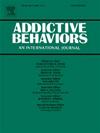Protective and risk factors in problematic mobile phone use among adolescents: A three-wave longitude study
IF 3.7
2区 医学
Q1 PSYCHOLOGY, CLINICAL
引用次数: 0
Abstract
Adolescents’ problematic mobile phone use (PMPU) has become increasingly severe. This study examined the changes in relationships between dimensions of PMPU, protective (positive psychological capital, i.e., optimism, hope, resilience, core self-evaluation) and risk (psychological distress, i.e., anxiety, depression, loneliness, and stress) factors within the network, aiming to identify the most influential factors over time and find the longitudinal predictive relationships between the factors and PMPU. A total of 1,170 Chinese adolescents participated over three waves (T1: January 2023, T2: August 2023, T3: February 2024). Cross-section network analysis showed that “core self-evaluation”, “depression”, “hope”, “loss of control”, and “stress_P” were the central nodes. “Stress_N” (sense of losing control and negative affective reactions) in risk factors and “affect control” (ability to regulate emotions) in protective factors were the bridge symptoms in the network across three timepoints. As shown in network comparison, the global strength of the network remained stable from T1 to T2 but increased from T2 to T3. The edge strength between “family support”, “anxiety” and the nodes of PMPU weakened across the time. While, correlations between “loneliness”, “goal planning”, “positive thinking”, “affect control” and PMPU nodes strengthened. The relationship between “Stress_N” and PMPU initially increasing before decreasing. Longitudinal cross-lagged network analysis revealed that “negative life consequence” and “craving” in PMPU strongly predicted protective/risk factors, while “hope,” “affect control,” and “core self-evaluation” were most susceptible to prediction. The findings highlight the significant role of “core self-evaluation” and “stress_N” in the development of adolescents’ PMPU and the negative results of PMPU. Additionally, the changes in the network over time suggest that the factors influencing PMPU evolve, with various protective/risk factors gaining or losing significance at different stages. The results of CLPN emphasize the negative outcome of PMPU. Therefore, targeting interventions on the internalized symptoms may help alleviate the severity of PMPU among adolescents.
青少年不良手机使用的保护和危险因素:一项三波经度研究
青少年问题手机使用(PMPU)日益严重。本研究考察了PMPU各维度与网络内保护性(积极心理资本,如乐观、希望、弹性、核心自我评价)和风险性(心理困扰,如焦虑、抑郁、孤独和压力)因素之间的关系变化,旨在发现影响因素随时间的变化,并发现这些因素与PMPU之间的纵向预测关系。共有1170名中国青少年参加了三波(T1: 2023年1月,T2: 2023年8月,T3: 2024年2月)。横截面网络分析显示,“核心自我评价”、“抑郁”、“希望”、“失控”和“压力p”是中心节点。风险因素中的“压力n”(失控感和负面情感反应)和保护因素中的“情绪控制”(情绪调节能力)是网络跨越三个时间点的桥状症状。从网络对比中可以看出,从T1到T2,网络整体强度保持稳定,但从T2到T3,网络整体强度有所增加。“家庭支持”、“焦虑”和PMPU节点之间的边缘强度随着时间的推移而减弱。孤独感、目标规划、积极思考、情绪控制与PMPU节点的相关性增强。应力n与PMPU的关系先增大后减小。纵向交叉滞后网络分析显示,PMPU中的“消极生活后果”和“渴望”对保护/风险因素有较强的预测作用,而“希望”、“情感控制”和“核心自我评价”对保护/风险因素的预测作用最大。研究结果强调了“核心自我评价”和“压力n”在青少年PMPU发展中的显著作用以及PMPU的负面结果。此外,随着时间的推移,网络的变化表明影响PMPU的因素在不断发展,各种保护/风险因素在不同阶段获得或失去重要性。CLPN结果强调PMPU的阴性结果。因此,针对内化症状的干预可能有助于减轻青少年PMPU的严重程度。
本文章由计算机程序翻译,如有差异,请以英文原文为准。
求助全文
约1分钟内获得全文
求助全文
来源期刊

Addictive behaviors
医学-药物滥用
CiteScore
8.40
自引率
4.50%
发文量
283
审稿时长
46 days
期刊介绍:
Addictive Behaviors is an international peer-reviewed journal publishing high quality human research on addictive behaviors and disorders since 1975. The journal accepts submissions of full-length papers and short communications on substance-related addictions such as the abuse of alcohol, drugs and nicotine, and behavioral addictions involving gambling and technology. We primarily publish behavioral and psychosocial research but our articles span the fields of psychology, sociology, psychiatry, epidemiology, social policy, medicine, pharmacology and neuroscience. While theoretical orientations are diverse, the emphasis of the journal is primarily empirical. That is, sound experimental design combined with valid, reliable assessment and evaluation procedures are a requisite for acceptance. However, innovative and empirically oriented case studies that might encourage new lines of inquiry are accepted as well. Studies that clearly contribute to current knowledge of etiology, prevention, social policy or treatment are given priority. Scholarly commentaries on topical issues, systematic reviews, and mini reviews are encouraged. We especially welcome multimedia papers that incorporate video or audio components to better display methodology or findings.
Studies can also be submitted to Addictive Behaviors? companion title, the open access journal Addictive Behaviors Reports, which has a particular interest in ''non-traditional'', innovative and empirically-oriented research such as negative/null data papers, replication studies, case reports on novel treatments, and cross-cultural research.
 求助内容:
求助内容: 应助结果提醒方式:
应助结果提醒方式:


